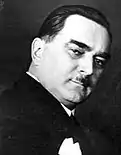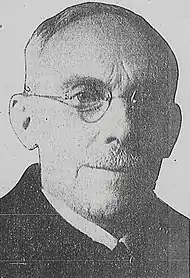1938 Yugoslavian parliamentary election
Parliamentary elections were held in Yugoslavia on 11 December 1938.[1] The result was a victory for the governing Yugoslav Radical Union, which won 306 of the 373 seats in Parliament.
| ||||||||||||||||||||||||||||
All 373 seats to the Narodna skupština | ||||||||||||||||||||||||||||
|---|---|---|---|---|---|---|---|---|---|---|---|---|---|---|---|---|---|---|---|---|---|---|---|---|---|---|---|---|
| Turnout | 74.5% | |||||||||||||||||||||||||||
| ||||||||||||||||||||||||||||
| ||||||||||||||||||||||||||||
These would be the last elections held in Yugoslavia before World War II. By the time of the first postwar elections, in 1945, a Communist regime was rapidly consolidating, and the non-Communist opposition boycotted the vote after claiming to have been targeted with severe intimidation.[2] As a result, the 1938 elections would be the last multi-party elections held in Yugoslavia until the Communists gave up their monopoly of power in 1990.[3]
Coalitions
The Yugoslav Radical Union (JRZ, Jereza) led by PM Milan Stojadinović, form an right-wing alliance with:
- Yugoslav National Party led by Bogoljub Jevtić,
- Yugoslav Muslim Organization led by Mehmed Spaho,
- Slovene People's Party led by Anton Korošec and
- People's Radical Party led by Aca Stanojević, which later leaves the alliance in favor of the United Opposition.
The United Opposition alliance was consisted of:
- Croatian Peasant Party led by Vladko Maček
- Independent Democratic Party led by Srđan Budisavljević
- Democratic Party led by Ljubomir Davidović
- Agrarian Party led by Jovan Jovanović Pižon
- Montenegrin Federalist Party led by Sekula Drljević
Results
| Party | Votes | % | Seats | +/– |
|---|---|---|---|---|
| Yugoslav Radical Union | 1,643,783 | 54.1 | 306 | +3 |
| United Opposition | 1,364,524 | 44.9 | 67 | 0 |
| Yugoslav National Movement | 30,734 | 1.0 | 0 | 0 |
| Total | 3,039,041 | 100 | 373 | +3 |
| Registered voters/turnout | 4,080,286 | 74.5 | – | – |
| Source: Nohlen et al. | ||||
Aftermath
Although the United Opposition, de facto led by Maček, had attracted 44.9% of the vote, due to the electoral rules by which the government parties received 40% of the seats in the National Assembly before votes were counted, the opposition vote only translated into 67 seats out of a total of 373.[4]
Following the election, there was a faction led by the commander of the Royal Yugoslav Air Force (VVKJ), General Dušan Simović, that contemplated a pro-Serb coup. Simović had been involved in similar plotting earlier in the year.[5]
Sources
- Onslow, Sue (March 2005). "Britain and the Belgrade Coup of 27 March 1941 Revisited" (PDF). Electronic Journal of International History. University of London (8): 359–370. ISSN 1471-1443.CS1 maint: ref=harv (link)
- Ramet, Sabrina P. (2006). The Three Yugoslavias: State-Building and Legitimation, 1918–2005. Bloomington, Indiana: Indiana University Press. ISBN 978-0-253-34656-8.CS1 maint: ref=harv (link)
References
- Dieter Nohlen, Dolf Sternberger, Bernhard Vogel, Klaus Landfried (1969) Die Wahl der Parlamente und andere Staatsorgane, Walter de Gruyter, p784
- "Elections In Yugoslavia", The Times, 9 November 1945
- Rome Tempest (January 23, 1990). "Communists in Yugoslavia Split Into Factions". Los Angeles Times.
- Ramet 2006, p. 104.
- Onslow 2005, p. 37.

